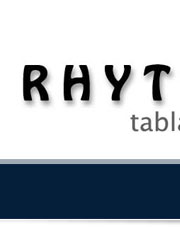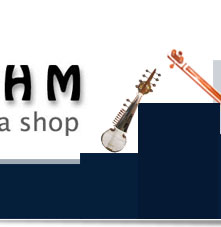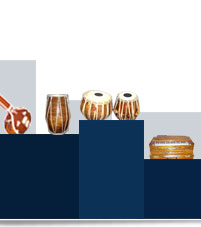|
ABOUT US |
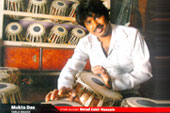 Open Magazine Coverage (Read Now) Open Magazine Coverage (Read Now) Mukta Das - Telegraph Press Coverage Mukta Das - Telegraph Press Coverage
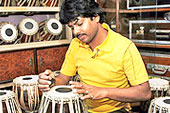 Telegraph Press Coverage Telegraph Press Coverage
|
Mukta Das was born into a family lineage of 11 generations of tabla makers. His Father's Grandfather, the great master Surandrnhath Das had previously set the level. Mukta worked in his father's shop with his two elder and three younger brothers, as well his sister's children in their home village of Ranaghat Nadiya. In 1986 Mukta made a big decision and moved to Kolkata to begin Talim (training) under the great Tabla making Guru Nariyan Das. After fifteen years of dedicated work in Nariayan Das's tabla shop, Mukta began thinking that one day he could have his very own shop. In Behala Sholshoena, the Behala district of Kolkata "Rhythm" came to be Mukta's first shop. It was there that Mukta made some major strides in developing his quality. He also obtained a world wide export license in 1999. " Rhythm " then flourished. One Year later Mukta supplied The I.T.C Sangeet Research Academy with all new instruments and built a new and bigger shop in the Tollygunge area of south Kolkata. |
Mukta understands that akin to the quality of workmanship is the quality of materials. He chooses camel hide straps and obtains his goat hides directly from the Kalighat temple, a most holy site for all Hindu's. At this point Mukta is well established as one of the best Tabla makers of India, if not the world. Mukta now exports instruments across the globe to the UK, the USA, Canada, Japan, and other various countries in South America, Africa, and Europe. He faithfully supplies tablas for great tabla masters such as Pandit Krishan Maharaj, Pandit Shankar Ghosh, Pandit Swapan Chowdhury, Ustad Zakir Hussain, Pandit Annindo Chatterjee, Pandit Kumar Bose, Pandit Samar Saha, Pandit Shures Tawalkar, and Pandit Bickram Ghosh. Mukta also provides continuous support for Indian as well international students worldwide. Mukta is happily married as of 2001. In 2003 he became the proud father of his daughter "kiti." |
| |
Dholak: Is a barrel shaped percussion instrument originating from the folk tradition of Northern India. The body is made of hollowed wood. Both ends are covered with tanned animal skin and bound by a rim and rope. |
| |
| Tabla: Comprised of a twin drum set. Combining the base tones of the drum called bayan and the treble of the right Dahina. The Bayan is a hollow bowl shape made of such metals as copper, bronze and cover. The Dahina is carved of woods such as mahogany, sesom and nimh. It is cylindrical as well hollow. The skins of the dahina and bayan are made from goat and cow hide. The skin is a multilayered arrangement with the bottom and top layer as a rim and the middle the resonating layer entitled " Shure". The gab, a paste of iron filling and cooked white rice is applied at the centre of the "shure". Tabla is tuned through the tightening of the "chhad," camel hide straps, as well the use of wooden dowels entitled "Gulie". Bayan is very similar in construction however small differences are present. The skin may be lacking the bottom ring layer. The Gab is applied off center. As well the use of "guile" is commonly applied subsequent to a period of usage. |
| |
Pakhawaj: A highly resonating, ancient classical drum. It is a barrel shaped drum made of hollowed wood, covered with goat hide at both ends. The drum is tuned by straps running through the hide. The treble-side comes with a permanent central black circle called a dab, while on the bass-side, a fresh dough is made and applied before each performance. |
| |
Sarangi: This ancient classical Hindustani string instrument is played with a bow and held vertically. There are three main playing strings running from the top that cross numerous bridges. Underneath there are numerous resonating strings. The Saringi is unique in that most string instruments vary pitch by applying pressure on the top of the string against the fret of the instrument. Contrastively, the Sanringi strings are very thick and so pressure is applied to the side of the sting as oppose to the top using the cuticle of the finger. |
| |
Sarode: Is a long necked Classical Hindustani instrument comprised of numerous materials. The head, neck and body are made of wood. The body is round resembling a drum as it is skinned. The neck of Sarode is a smooth fretless surface plated with steel. The strings run from the bridge which is placed at the centre of body, and connect to wooden pegs lined along the top of the neck and head. Underneath are numerous sympathetic resonating strings. The Sarode is played using a plectrum of dried and shaped coconut shell. |
| |
Sitar: Is sometimes described as the most popular Hindustani string instrument of all. The Sitar has long neck made of wood with movable frets. The Sitar has sympathetic stings that run from the bridge underneath the frets to tuning pegs at the head. There are also main strings connected to the tuning pegs and bridge, but these instead lay on top of the frets. At the base of Sitar is a gourd. Some models are equipped with one extra gourd at the top of the neck to enhance sound resonance. The Sitar is played using a wire plectrum. |
| |
Tanpura: Are the background droning instruments of classical Hindustani. Tanpura vary in size and number of strings depending on whether being used for female or male accompaniment, or for vocal or instrumental accompaniment. Vocal Tanpuras have a long neck, they have wooden tuning pegs at the head of the neck, a bridge connecting 4 - 6 strings, and a large gourd as the base of the instrument. Instrumental Tanpuras differ only in size as they are generally shorter and the base is not such a large gourd but still comprised of hollowed wood. |
| |
Harmonium: During the mid-19th century, missionaries brought French-made hand-pumped harmoniums to India. The instrument quickly became popular and adopted by Hindustani classical. Harmoniums consist of banks of brass reeds (metal tongues which vibrate when air flows over them), a pumping apparatus, stops for drones (some models feature a stop which causes a form of vibrato), and a keyboard. The Harmonium can be equipped with a scale changer providing the player with a wider range of octaves. |
| |
Dholaki: is a very popular folk drum of northern India. It is barrel shaped with a thin skin on the right hand side. The left hand is also a thin skin with a special application on the inner surface. This application is a mixture of tar, clay, and sand, entitled dholak masala, which lowers the pitch and provides a defining tone. There are two ways of tuning the dholak. The use of laced with rope, in which case, a series of metal rings are pulled to tighten the instrument. Or, metal turnbuckles can be employed. |
|
